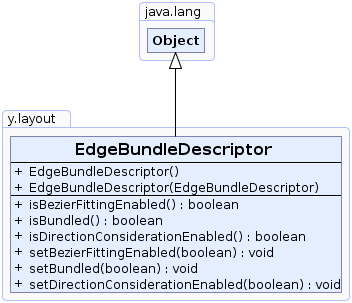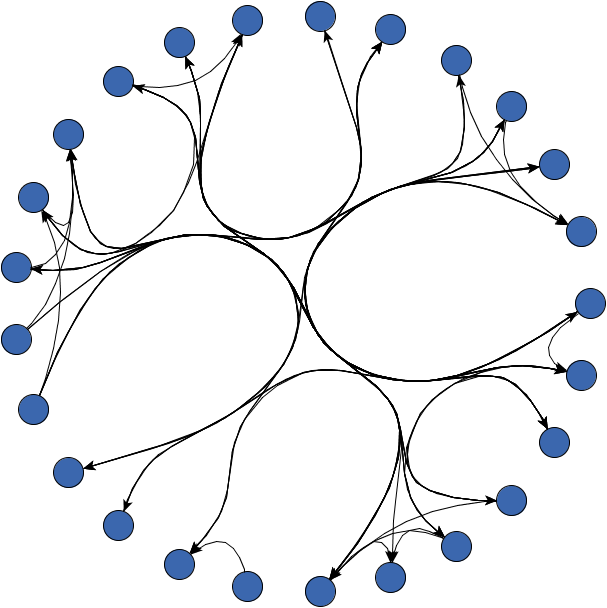 y.layout.EdgeBundleDescriptor
y.layout.EdgeBundleDescriptor
|
Search this API | ||||||||
| PREV CLASS NEXT CLASS | FRAMES NO FRAMES | ||||||||
| SUMMARY: NESTED | FIELD | CONSTR | METHOD | DETAIL: FIELD | CONSTR | METHOD | ||||||||
java.lang.Objecty.layout.EdgeBundleDescriptor
public class EdgeBundleDescriptor
An EdgeBundleDescriptor defines the bundling settings of an edge.
The defined settings will be considered by layout algorithms which support edge bundling.
Each EdgeBundleDescriptor can either be specified for a single edge or shared by several edges.
It is assigned to an edge by registering a DataProvider with key
EdgeBundling.EDGE_BUNDLE_DESCRIPTOR_DPKEY to the input graph.
EdgeBundling,
EdgeBundling.EDGE_BUNDLE_DESCRIPTOR_DPKEY
| Constructor Summary | |
|---|---|
EdgeBundleDescriptor()
Creates a new EdgeBundleDescriptor with default settings. |
|
EdgeBundleDescriptor(EdgeBundleDescriptor descriptor)
Creates a new EdgeBundleDescriptor representing a copy of the given other descriptor instance. |
|
| Method Summary | |
|---|---|
boolean |
isBezierFittingEnabled()
Returns whether or not a bezier curve should be fit to an edge associated to this descriptor. |
boolean |
isBundled()
Returns whether or not an edge associated to this descriptor should be bundled. |
boolean |
isDirectionConsiderationEnabled()
Returns whether or not the direction of the edge associated to this descriptor should be considered. |
void |
setBezierFittingEnabled(boolean bezierFittingEnabled)
Specifies whether or not a bezier curve should be fit to an edge associated to this descriptor. |
void |
setBundled(boolean bundled)
Specifies whether or not an edge associated to this descriptor should be bundled. |
void |
setDirectionConsiderationEnabled(boolean directionConsiderationEnabled)
Specifies whether or not the direction of the edge associated to this descriptor should be considered. |
| Methods inherited from class java.lang.Object |
|---|
clone, equals, finalize, getClass, hashCode, notify, notifyAll, toString, wait, wait, wait |
| Constructor Detail |
|---|
public EdgeBundleDescriptor()
EdgeBundleDescriptor with default settings.
public EdgeBundleDescriptor(EdgeBundleDescriptor descriptor)
EdgeBundleDescriptor representing a copy of the given other descriptor instance.
descriptor - the descriptor to copy| Method Detail |
|---|
public boolean isDirectionConsiderationEnabled()
During the bundling procedure, the edges are bundled based on their direction such that the incoming edges of a node are bundled separately from its outgoing edges. If the direction of edges adjacent to a node is not considered, then they are not bundled separately.
If the direction of some edges is taken into consideration while the direction of some others (adjacent to the same node) is ignored, the undirected edges are also bundled separately. This is done to distinguish them from the incoming and outgoing edges of the particular node.
EdgeBundlingStage, this property does not affect the result because
all edges are always considered to be undirected.true if the direction of the edge is considered,
false otherwisesetDirectionConsiderationEnabled(boolean)public void setDirectionConsiderationEnabled(boolean directionConsiderationEnabled)
During the bundling procedure, the edges are bundled based on their direction such that the incoming edges of a node are bundled separately from its outgoing edges. If the direction of edges adjacent to a node is not considered, then they are not bundled separately.
If the direction of some edges is taken into consideration while the direction of some others (adjacent to the same node) is ignored, the undirected edges are also bundled separately. This is done to distinguish them from the incoming and outgoing edges of the particular node.
EdgeBundlingStage, this property does not affect the result because
all edges are always considered to be undirected.directionConsiderationEnabled - true if the direction of the edge should be considered,
false otherwise false |  true |
public boolean isBundled()
true if an edge associated to this descriptor is bundled,
false otherwisesetBundled(boolean)public void setBundled(boolean bundled)
bundled - true if an edge associated to this descriptor should be bundled,
false otherwisepublic boolean isBezierFittingEnabled()
If disabled, the edges resemble B-splines where points of the path are actually curve points. Therefore, this representation requires a high number of bends to model curves.
If this feature is enabled, a bezier curve is fitted to the start and end point as well as the intermediate control points of the edge. After the fitting, the points of the edge can be interpreted as cubic bezier control points. Each four consecutive points form a bezier curve, where the first and last of the four points represent the start and end of the curve and the second and third point are the control points defining how the curve looks. The second and third point do not necessarily lie on the actual curve.
true if a bezier curve is fitted to an edge associated with this descriptor,
false otherwisesetBezierFittingEnabled(boolean)public void setBezierFittingEnabled(boolean bezierFittingEnabled)
If disabled, the edges resemble B-splines where points of the path are actually curve points. Therefore, this representation requires a high number of bends to model curves.
If this feature is enabled, a bezier curve is fitted to the start and end point as well as the intermediate control points of the edge. After the fitting, the points of the edge can be interpreted as cubic bezier control points. Each four consecutive points form a bezier curve, where the first and last of the four points represent the start and end of the curve and the second and third point are the control points defining how the curve looks. The second and third point do not necessarily lie on the actual curve.
bezierFittingEnabled - true if a bezier curve should be fitted to an edge associated with this
descriptor, false otherwise
|
© Copyright 2000-2025, yWorks GmbH. All rights reserved. |
||||||||
| PREV CLASS NEXT CLASS | FRAMES NO FRAMES | ||||||||
| SUMMARY: NESTED | FIELD | CONSTR | METHOD | DETAIL: FIELD | CONSTR | METHOD | ||||||||